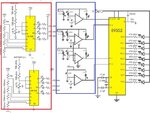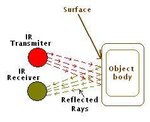Eshal
Advanced Member level 1
- Joined
- Aug 29, 2012
- Messages
- 470
- Helped
- 16
- Reputation
- 32
- Reaction score
- 15
- Trophy points
- 1,298
- Location
- Nowhere :)
- Activity points
- 5,149
Hello to all experts,
I have been given a project as described in the subject of this thread and I have found **broken link removed** this resource over the internet.
You can see there is a schematic in the given link which is also shown below

In this schematic, he has used two ICs of LM339 one is connected with solar cell and other is connected with battery.
My first question is:
Do I need to use both for this project? Or anyone?
And then he has connected 4 amplifiers to the pins (p1.0, p1.1, p1.2, p1.3) of the microcontroller. I have asked the author of this article via pm about these amplifiers. He replied these are LM339 quad comparator.
My second question is:
What are those LM339 IC's (blue) and what are these LM339 IC's (red) because if both are same then (means a single IC) both have same components connected to them.
Best regards,
Princess
I have been given a project as described in the subject of this thread and I have found **broken link removed** this resource over the internet.
You can see there is a schematic in the given link which is also shown below

In this schematic, he has used two ICs of LM339 one is connected with solar cell and other is connected with battery.
My first question is:
Do I need to use both for this project? Or anyone?
And then he has connected 4 amplifiers to the pins (p1.0, p1.1, p1.2, p1.3) of the microcontroller. I have asked the author of this article via pm about these amplifiers. He replied these are LM339 quad comparator.
My second question is:
What are those LM339 IC's (blue) and what are these LM339 IC's (red) because if both are same then (means a single IC) both have same components connected to them.
Best regards,
Princess
Last edited:
